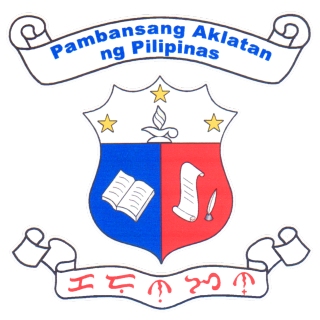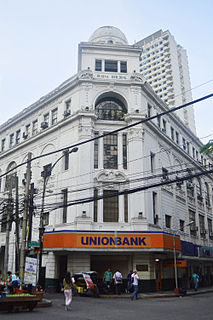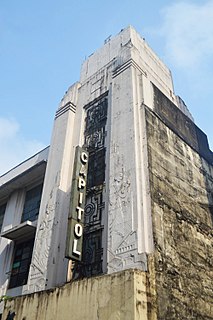
Filipino is the national language of the Philippines. Filipino is also designated, along with English, as an official language of the country. It is a standardized variety of the Tagalog language, an Austronesian regional language that is widely spoken in the Philippines. Tagalog is the first language of 24 million people or about one-fourth of the Philippine population as of 2019, while 45 million speak Tagalog as their second language as of 2013. Tagalog is among the 185 languages of the Philippines identified in the Ethnologue. Officially, Filipino is defined by the Commission on the Filipino Language as "the native dialect, spoken and written, in Metro Manila, the National Capital Region, and in other urban centers of the archipelago". As of 2000, over 90% of the population could speak Tagalog, approximately 80% could speak Filipino and 60% could speak English.
Rajah Sulayman, sometimes referred to as Sulayman III (1558–1575), was the Rajah of Maynila, a fortified Tagalog Muslim polity on the southern half of the Pasig River delta, when a Spanish expedition arrived in the early 1570s.

Miguel Malvar y Carpio was a Filipino general who served during the Philippine Revolution and, subsequently, during the Philippine–American War. He assumed command of the Philippine revolutionary forces during the latter, following the capture of resistance leader Emilio Aguinaldo by the Americans in 1901. According to some historians, he could have been listed as one of the presidents of the Philippines but, as of 2022, is not recognized as such by the Philippine government.

The National Library of the Philippines is the official national library of the Philippines. The complex is located in Ermita on a portion of Rizal Park facing T. M. Kalaw Avenue, neighboring culturally significant buildings such as the Museum of Philippine Political History and the National Historical Commission. Like its neighbors, it is under the jurisdiction of the National Commission for Culture and the Arts (NCCA).

The 1990 Luzon earthquake struck the island of Luzon in the Philippines at 4:26 p.m. on July 16 (PDT) or 3:26 p.m. (PST) with an estimated moment magnitude of 7.7 and a maximum Mercalli intensity of IX (Violent) and produced a 125 km-long ground rupture that stretched from Dingalan, Aurora to Kayapa, Nueva Vizcaya. The event was a result of strike-slip movements along the Philippine Fault and the Digdig Fault within the Philippine Fault System. The earthquake's epicenter was near the town of Rizal, Nueva Ecija, northeast of Cabanatuan City. An estimated 1,621 people were killed, most of the fatalities located in Central Luzon and the Cordillera region.

The architecture of the Philippines reflects the historical and cultural traditions in the country. Most prominent historic structures in the archipelago are influenced by Austronesian, Chinese, Spanish, and American architectures.
Vaudeville in the Philippines, more commonly referred to as bodabil, was a popular genre of entertainment in the Philippines from the 1910s until the mid-1960s. For decades, it competed with film, radio and television as the dominant form of Filipino mass entertainment. It peaked in popularity during the Japanese occupation in the Philippines from 1941 to 1945. Many of the leading figures of Philippine film in the 20th century, such as Dolphy, Nora Aunor, Leopoldo Salcedo and Rogelio de la Rosa, began their showbusiness careers in bodabil.

Pablo Sebero Antonio, Sr. was a Filipino architect. A pioneer of modern Philippine architecture, he was recognized in some quarters as the foremost Filipino modernist architect of his time. The rank and title of National Artist of the Philippines was conferred on him by President Ferdinand Marcos in 1976.

The Metrobank Center is a 318 m (1,043 ft) mixed-used skyscraper, located in Bonifacio Global City, Taguig, Metro Manila. It has been the tallest building in the Philippines since its completion in 2017.

The Manila Central Post Office, often called the Post Office Building, is the main postal office of Manila, which also serves as the home of the Philippine Postal Corporation. It also houses the main mail sorting-distribution operations of the Philippines.

The Manila City Hall is the official seat of government of the City of Manila, located in the historic center of Ermita, Manila. It is where the Mayor of Manila holds office and the chambers of the Manila City Council is located. It was originally intended to be a part of a national government center envisioned by Daniel Burnham in the 1900s. Although the dream plan was not fully implemented, some buildings for the proposed government center were constructed, including the Old Legislative Building, and the Agriculture and Finance Buildings.

The history of the Philippines from 1565 to 1898 is known as the Spanish colonial period, during which the Philippine Islands were ruled as the Captaincy General of the Philippines within the Spanish East Indies, initially under New Spain until Mexican independence from Spain in 1821, resulting in direct Spanish control during a period of governmental instability there.

The Elks Club Building is the second and former clubhouse of the Manila Elks Lodge #761—Manila Lodge 761, better known as the Manila Elks Club, in Manila, the Philippines. It was designed by William E. Parsons.

The First United Building, formerly known and still commonly referred to as Perez-Samanillo Building, is an Art Deco building on Escolta Street in Binondo, Manila, Philippines. It was designed by Andrés P. Luna, the son of renowned painter Juan Luna, and was the tallest building in Manila when it was completed in 1928.

Regina Building, previously known as Roxas Building, is a historic building located along Escolta Street in Binondo, Manila, Philippines. It was designed sequentially by Andrés Luna de San Pedro and Fernando H. Ocampo. The neoclassical beaux-arts commercial structure was built in 1915.

Bellevue Theater is a small theater located in Paco district, Manila, Philippines. The theater adopted Philippine Islamic imagery as its art deco theme, borrowing inspiration from the tradition of moro-moro theatrical scenography.

The Capitol Theater was an Art deco theater in Manila, Philippines. It was built during the 1930s along Escolta Street, part of the city's primary commercial district, together with the Lyric Theater. It was designed with a double-balcony by National Artist Juan Nakpil and that was considered a rare feat during that era.

The Our Lady of the Pillar Parish Church, commonly known as the Santa Cruz Church and also designated as the Archdiocesan Shrine of the Blessed Sacrament, is a baroque Roman Catholic parish church in the district of Santa Cruz, Manila, Philippines. It was built when the arrabal (suburb) of Santa Cruz was established by the Jesuits in the early 17th century. The church had undergone many repairs and reconstruction, with the last reconstruction done in the 1950s. It is the first Mission and Mother house of Filipino Sacramentinos, making it as the center of Congregation Activities and events

The Tanghalang Pambansa, formerly Theater of Performing Arts, is a theater located in the Cultural Center of the Philippines Complex in Manila, Philippines.

















